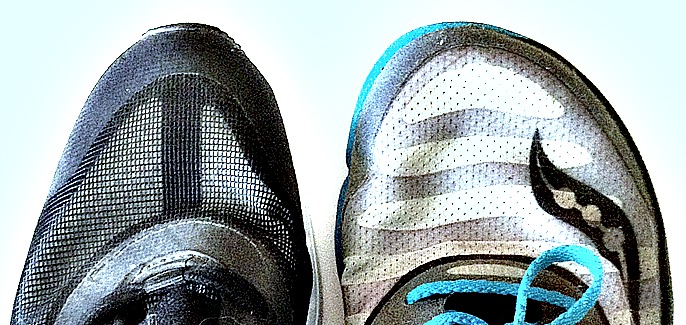Wide minimalist running shoes not only spread your toes for better balance, grip and shock absorption during forefoot running, they also prevent biomechanical toe trauma as well as nail disorders as compared with the standard running shoe –a shoe typically worn by heel strike runners which generally has a pointed toe box to facilitate foot rollover.

The Benefits of Wide Minimalist Running Shoes
Runners who prefer narrow running shoes have a higher rate of medial forefoot pain compared to runners who wear wide barefoot running shoes –shoes with a rounded, wider toe box.
A recent study by Branthwaite et al. revealed that a narrow running shoe increased peak pressures around the medial forefoot with a greater pressure time integral as well.
- Increased peak pressure around the medial forefoot during heel strike running may be the mechanism underlying metatarsal stress fracture of the 2nd metatarsal head.
It gets even worse.
According to Mann (2007), the forefoot is meant to expand during ground contact, but narrow running shoes prevents this from happening, and adds more pressure on the forefoot, particularly increased lateral pressures which changes the nail matrix orientation, such as nail plate thickening, leading to toe pain. The worst case scenario from this is that the seal between the nail plate and the nail bed breaks, allowing fungus to enter the nail unit, Mann reported.
Why Wider is Better
Wide toe box running shoes allows the dorsal digital area to splay out more, which might be particularly relevant to effectively dissipate plantar pressures. In contrast, pointy-toed running shoes essentially warps the natural contours of the digits, the 1st and 5th digit being most affected with increased time to peak pressure and contact.
The current study showed that footwear with a rounded toe-box which correlated to the natural anatomical contours of the foot, was associated with the lowest pressure values.
Based on their data, increased mechanical strain to the foot can arise if the shape of the toe box of a running shoe does not follow the anatomy of the human foot. To avoid foot pain, the toe-box shape should reflect that of the bare foot.
More From Run Forefoot:
Why the Hips Function Better in Forefoot Running
Don’t Over-Think Your Mechanics When You Run
Dealing with Achilles Injury From Running
Most Popular Barefoot Running Shoes for Forefoot Running
References:
Branthwaite H., Chockalingam N and Greenhalgh A. The effect of shoe toe box shape and volume on forefoot interdigital and plantar pressures in healthy females. J Foot Ankle Res, 2013; 6(23):2-9.
Mann, A. Narrow shoes behind refractory nail thickening. Skin & Allergy News.32.7 (July 2001):p 34.
Bretta Riches
BSc Neurobiology; MSc Biomechanics candidate, ultra minimalist runner & founder of RunForefoot. I was a heel striker, always injured. I was inspired by the great Tirunesh Dibaba to try forefoot running. Now, I'm injury free. This is why I launched Run Forefoot, to advocate the health & performance benefits of forefoot running and to raise awareness on the dangers of heel striking, because the world needs to know.
Latest posts by Bretta Riches (see all)
- Does Foot Strike Really Matter in Running? YES! - 17/04/2024
- Heel Lifts Increase Injury in Runners - 16/04/2024
- Are Minimalist Shoes Good for Seniors? YES! - 14/04/2024

Hi Bretta, Its Russell again I was running in the Altra paradigm 34mm stack and found my training times getting slower. Do you think the Altra one 2,5s 23mm stack and 6,3 oz is also to much cushion ? Keep in mind I have very wide feet.
P.S I joined your instagragm Im Rocketrus.
Kindest Regards,
Russell